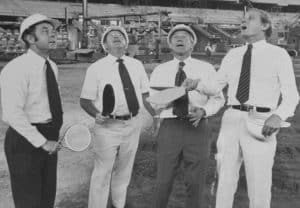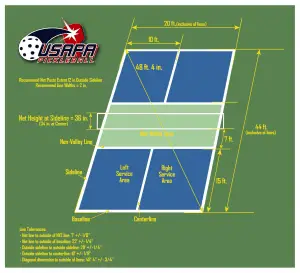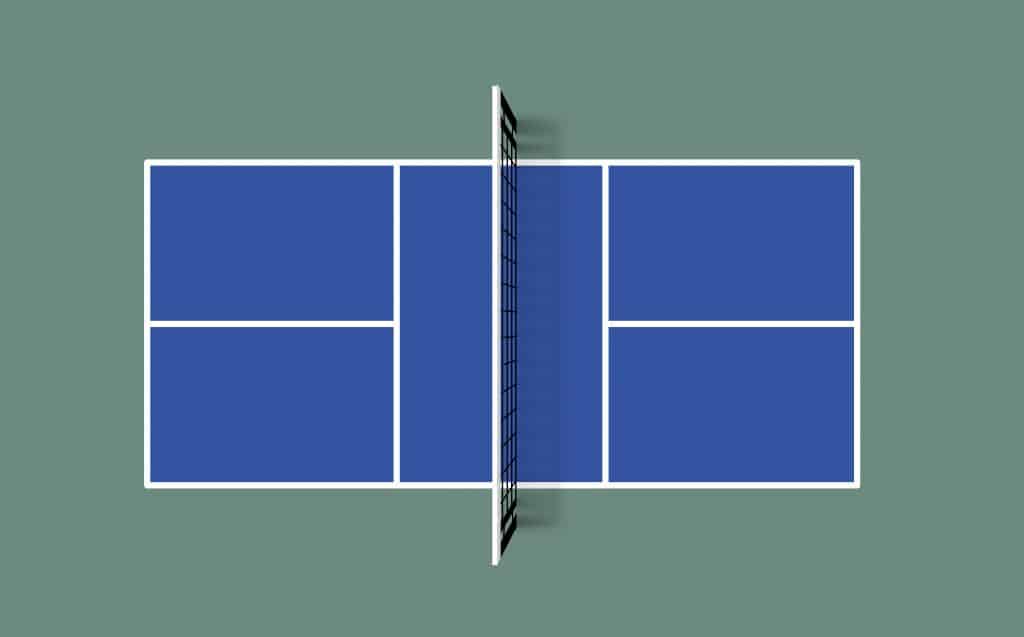Hey! This site is reader-supported and we earn commissions if you purchase products from retailers after clicking on a link from our site.
It’s possible to love a game and not know about the technical side. For instance, how long is a pickleball court? What goes into a pickleball court construction? What is the difference in the dimension between a pickleball and a tennis court? Sure, all of us have an overview in regards to size but that’s all.
Most of us are not aware of the technical side and thus today we’ll dive deep into all court-related information so you can use it to your advantage. Keep reading because today you’ll learn about different pickleball terms along with court dimensions and construction.
Let’s start first by understanding the history of pickleball.
The History of Pickleball
Pickleball as a sport began its journey in 1965. It was founded by Joel Pritchard, Bill Bell, and Barney McCallum – three dads whose kids were bored with a lack of summertime activities.
It took more than a decade before pickleball actually became popular. The first tournament was held in 1976 – 11 years after the initial discovery.

Image Credit: IFP
Since that tournament, the sport has captured the imagination of players from around the world from the continents of Europe, Asia, and North America. Though it’s not yet as mainstream on the global level, pickleball is played across all 50 states in the US. In 2001, the sport made its debut in the Arizona Senior Olympics held in 2001.
Now that we know enough about the history of pickleball, let’s check out the pickleball courts dimensions.
Pickleball Court Dimensions
A pickleball court generally measures 20 x 44 feet as per the USA Pickleball Association (USAPA). This dimension is the same size as that of a doubles badminton court. A pickleball court is sliced into two different parts with each side having a 22ft length thanks to the court lines.
The Kitchen area is 20×7 feet which provides each team with the playing area of 20×15 feet. I’d like to share some diagrammatic representation so you can understand the dimensions better.

Image Ref: USAPA
Based upon the diagram above, we can understand that each side of the court is divided into three different parts – Non-Volley Zone, Left Service Area, and Right Service Area. These different spaces are surrounded by a sideline, baseline, centerline, and Non-Volley Line. Apart from these elements, you have the net height which as per USAPA guidelines is 36 inches.
The pickleball court dimensions aren’t too complex to understand because of our familiarity with other sports. Converting an existing badminton or tennis court is quite easy because of the similarity.
The lines and borders, surface, and the playing area are quite similar to those sports except the size of a Pickleball court which is much smaller. If you’re interested in setting up your own indoor pickleball court, there are two additional details you must know.
Pickleball Court Net
Based upon the official pickleball rules, the pickleball net height has to be 22ft wide and 4 inches long. The height of the net shouldn’t be more than 36” and it shouldn’t surpass the 34” limit at the center.

Image Credit: USAPA Store
Pickleball Court Placement
Most rookies wanting to set up a court don’t pay much attention to the location. However, you shouldn’t overlook the importance of the outdoor pickleball court placement. Naturally, you want to focus on a few things – the sun and the shadows that will fall on the court. It’s ideal to set up your court from North to South direction so it isn’t in line with the East to West placement.
Constructing a Pickleball Court
Professional pickleball court construction is not a DIY project. If you want to build an indoor or an outdoor pickleball court you should hire a contractor. Moreover, just because you’re outsourcing doesn’t mean you don’t get involved at all. Communicate everything upfront and double-check the guidelines before the installation begins. Using the USAPA Pickleball court lines construction manual can be really handy.
Tips for Pickleball Court Construction
Now that I’ve clarified the two crucial elements when setting up a pickleball court, here are a few handy tips for Pickleball Court Construction.
- The contractor you hire should have at least a couple of years of experience in the same field
- Don’t hesitate to check out their past projects
- Verify the materials they’ll use such as paint and ask about the warranty beforehand
- Take their input as opposed to your preconceived ideas. For instance, modular court surfaces aren’t a wise option and thus you should ask the expert first before you spend the money
- Review all the court dimensions first before the construction commences and make everything clear to the contractor to avoid any mishap
Pickleball Court Terms
Understanding the pickleball court terms is essential for players in order to get familiar with the common terms thrown on the court. There are seven pickleball court terms that can help you communicate better with your partner. In case you’re into singles competition, it’ll help you understand instructions from your coach.

Baseline
The baseline on the pickleball court runs parallel to the net. It’s the last court lines on the court and can’t be crossed when you’re serving.
Centerline
The centerline refers to the midpoint on the court. It extends from the kitchen to the baseline. It’s the line that divides the pickleball court into two halves. The same as with tennis courts.
Kitchen
The kitchen area on the pickleball court is also known as the non-volley zone. It’s the 7 feet area on either side from where you cannot execute direct volleys.
No-Man’s Land
The No-Man’s land or Transition Zone is a specific area between the baseline and the kitchen. You should avoid positioning yourself in this area as it opens up angles for your opponent to smash at you.
Non-Volley Zone
Non-Volley Zone or the kitchen area is the closest section to the net. This area is within 7 feet on both sides of the net from where you’re not allowed to volley. The line behind the Non-volley zone is the best position for a pickleball player. When you play from there, you can easily reduce the number of angles from which your opponent can attack.
Sideline
The sideline on a pickleball court runs perpendicular to the net. This is the line that decides whether a shot was in or out.
Service Courts
The service pickleball courts are on either side of the centerline. This section is bounded by a non-volley line along with the sideline and a baseline.
Conclusion
If you’re in the US, there are many places to play pickleball. However, if you want to create your own indoor pickleball court, you can do so by reading about the USAPA guidelines and videos from pickleball experts.
If you’re serious about pickleball and want to compete professionally, I’d recommend you keep the size as close to the official guidelines. Doing so will help you understand the space better which can translate into a good performance on actual courts.
I hope this in-depth guide about Pickleball Court Dimensions helped you drive home with some valuable points about the court and the sport in general.
Leave a Reply